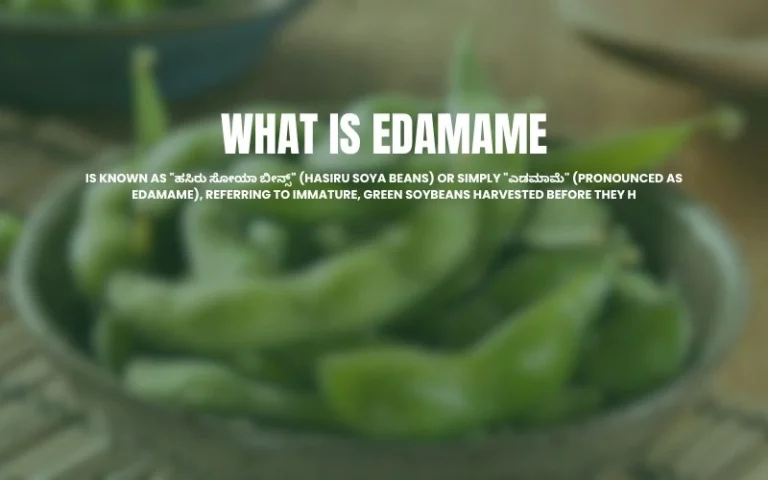Last Updated: October 8, 2025
Quick Answer: Edamame in Kannada is known as “ಹಸಿರು ಸೋಯಾ ಬೀನ್ಸ್” (Hasiru Soya Beans) or simply “ಎಡಮಾಮೆ” (pronounced as Edamame), referring to immature, green soybeans harvested before they harden.
Disclaimer: This article provides nutritional information about Edamame in Kannada for educational purposes only. While Edamame nutrition data is based on USDA databases and peer-reviewed sources, individual nutritional needs vary. The health benefits mentioned are supported by scientific research but should not replace professional medical advice. Always consult healthcare providers or registered dietitians for personalized nutrition guidance, especially if you have soy allergies, thyroid conditions, or are taking medications. The Edamame protein and nutrient values may vary slightly based on preparation methods and bean varieties.
Edamame Quick Facts Table
| Attribute | Details |
|---|---|
| Kannada Name | ಹಸಿರು ಸೋಯಾ ಬೀನ್ಸ್ (Hasiru Soya Beans) |
| Scientific Name | Glycine max |
| Origin | East Asia (China, Japan) |
| Protein Per 100g | 11-12 grams |
| Calories Per 100g | 122 kcal |
| Primary Nutrients | Protein, Fiber, Folate, Vitamin K |
| Best Consumption | Steamed or boiled with salt |
| Harvest Stage | Immature (green) soybeans |
What Exactly is Edamame? The Story Behind the Green Bean
Let me tell you a story. Picture yourself walking through a bustling Japanese restaurant, and you notice these cute little green pods on almost every table. People are popping beans out of fuzzy pods, sprinkling salt, and munching away happily. That’s Edamame—and it’s basically soybeans that decided to stay young and green forever!
What is Edamame? Simply put, Edamame are young soybeans still in their pods, harvested before they mature and harden. Unlike the yellow, dried soybeans you might know, these green gems are tender, slightly sweet, and packed with nutrition.
The word “edamame” literally translates to “beans on branches” in Japanese. While Edamame in Kannada translates to ಹಸಿರು ಸೋಯಾ ಬೀನ್ಸ್, many Kannada speakers simply use the term “ಎಡಮಾಮೆ” because, well, it sounds cool and everyone knows what you’re talking about!
Edamame Across Indian Languages: Speaking the Bean Language
India’s linguistic diversity means one food gets many names. Here’s how Edamame translates across different Indian languages:
| Language | Translation | Pronunciation |
|---|---|---|
| Kannada | ಹಸಿರು ಸೋಯಾ ಬೀನ್ಸ್ | Hasiru Soya Beans |
| Hindi | हरी सोयाबीन | Hari Soyabean |
| Marathi | हिरव्या सोयाबीन | Hirvya Soyabean |
| Tamil | பச்சை சோயா பீன்ஸ் | Pachai Soya Beans |
| Telugu | పచ్చి సోయా బీన్స్ | Pacchi Soya Beans |
| Gujarati | લીલા સોયાબીન | Leela Soyabean |
| Bengali | কাঁচা সয়াবিন | Kacha Soyabin |
So whether you call it Edamame in Hindi (हरी सोयाबीन), Edamame in Marathi (हिरव्या सोयाबीन), Edamame in Tamil, Edamame in Telugu, Edamame in Gujarati, or Edamame in Bengali—you’re all talking about the same delicious green superfood!
Many people also search for Edamame Beans in Hindi, which is simply हरी सोयाबीन की फलियाँ (Hari Soyabean ki Phaliyan).
The Protein Powerhouse: Edamame Nutrition Breakdown
Now, let’s talk about why everyone’s obsessed with these little green beans. The Edamame nutrition profile reads like a health enthusiast’s dream come true!
Complete Nutritional Table (Per 100g Serving)
| Nutrient | Amount | % Daily Value |
|---|---|---|
| Calories | 122 kcal | 6% |
| Protein | 11g | 22% |
| Carbohydrates | 10g | 3% |
| Dietary Fiber | 5g | 20% |
| Fat | 5g | 8% |
| Folate | 311 mcg | 78% |
| Vitamin K | 31 mcg | 39% |
| Iron | 2.3 mg | 13% |
| Magnesium | 64 mg | 16% |
| Calcium | 63 mg | 6% |
Why Edamame Protein is Special
When we talk about Edamame protein, we’re not just discussing quantity—we’re talking quality. Edamame Beans contain all nine essential amino acids, making them a complete protein source. This is rare for plant foods!
The Edamame protein per 100g ranges from 11-12 grams, which is impressive for a vegetable. To put this in perspective, that’s about the same protein content as two eggs or a glass of milk. The Edamame beans protein per 100g makes them an excellent choice for vegetarians, vegans, and anyone looking to boost their protein intake naturally.
Health Benefits That’ll Make You Love Edamame in Kannada
The benefits of Edamame in Kannada (ಹಸಿರು ಸೋಯಾ ಬೀನ್ಸ್) go way beyond just protein. Let me break down why these green pods deserve a spot on your plate:
1. Muscle Building and Repair
Thanks to the high-quality Edamame protein, these beans support muscle growth and tissue repair. Perfect for gym-goers and athletes!
2. Heart Health Champion
Edamame Beans are rich in omega-3 and omega-6 fatty acids, which help reduce bad cholesterol and promote cardiovascular health.
3. Bone Strength Booster
With generous amounts of calcium, magnesium, and vitamin K, Edamame supports strong bones and may reduce osteoporosis risk.
4. Blood Sugar Regulation
The high fiber and protein content in Edamame in Kannada helps stabilize blood sugar levels, making them diabetes-friendly.
5. Weight Management Ally
Low in calories but high in protein and fiber, Edamame nutrition keeps you fuller longer without packing on pounds.
6. Pregnancy Superfood
The exceptional folate content (78% of daily value!) makes Edamame crucial for pregnant women and fetal development.
How to Eat Edamame: From Pod to Plate
So you’ve got your hands on some Edamame in Kannada (ಹಸಿರು ಸೋಯಾ ಬೀನ್ಸ್)—now what? Don’t worry; how to eat Edamame is easier than you think!
The Traditional Method
- Boil or Steam: Cook Edamame Beans in salted water for 5-7 minutes
- Drain and Season: Sprinkle with sea salt or your favorite spices
- Pop and Enjoy: Place the pod in your mouth, bite gently, and squeeze the beans out
- Discard the Pod: The fuzzy pods aren’t edible—only the beans inside!
Creative Ways to Enjoy
- Snack Bowl: Serve warm with coarse salt as a healthy appetizer
- Salad Topper: Shell the beans and toss into salads for extra protein
- Stir-Fry Addition: Add to vegetable stir-fries for texture and nutrition
- Hummus Alternative: Blend cooked beans into a smooth spread
- Rice Bowl Buddy: Mix with grains, veggies, and dressing
Delicious Edamame Recipes to Try at Home
Ready to get cooking? These Edamame recipes will transform your meals from boring to brilliant!
1. Spicy Masala Edamame (Kannada Style)
Ingredients:
- 2 cups Edamame Beans (in pods)
- 1 tsp red chili powder
- 1/2 tsp turmeric
- 1 tsp chat masala
- Salt to taste
- Lemon juice
Method: Boil Edamame in Kannada style with salt for 6 minutes. Drain and toss with spices while hot. Squeeze lemon juice before serving. Perfect evening snack!
2. Edamame Coconut Curry
Blend Edamame with coconut milk, curry leaves, mustard seeds, and green chilies for a South Indian twist that’ll make your taste buds dance.
3. Edamame Upma
Replace traditional semolina with shelled Edamame Beans for a protein-packed breakfast that keeps you energized all morning.
Growing Edamame: Can You Find Edamame Seeds in India?
Many gardening enthusiasts ask about Edamame seeds. Good news! You can grow Edamame in India, especially in cooler regions.
Growing Tips:
- Edamame seeds are essentially soybean seeds harvested for immature consumption
- Plant during cooler months (October-February in most regions)
- Requires well-drained soil and moderate watering
- Harvest when pods are plump but still green (75-80 days after planting)
- Available from specialty seed suppliers and online agricultural stores
Where to Buy Edamame in India
Finding Edamame in Kannada-speaking regions (Karnataka) has become easier:
- Major Supermarkets: More, Reliance Fresh, Spencer’s
- Online Platforms: BigBasket, Amazon Fresh, Flipkart
- Specialty Stores: Japanese and Asian food stores
- Farmers Markets: Some organic markets in Bangalore
- Frozen Section: Most commonly available frozen
Edamame vs Regular Soybeans: What’s the Difference?
| Feature | Edamame | Regular Soybeans |
|---|---|---|
| Harvest Stage | Immature (green) | Fully mature (yellow) |
| Texture | Tender, slightly sweet | Hard, requires soaking |
| Taste | Fresh, mild | Nutty, earthy |
| Preparation | Quick boil (5-7 min) | Long soak + extended cooking |
| Appearance | Bright green pods | Dried yellow beans |
| Best Use | Snacking, fresh dishes | Tofu, tempeh, soy products |
Expert Insights on Edamame Consumption
Dr. Priya Sharma, Clinical Nutritionist, Bangalore: “Edamame in Kannada communities is gaining popularity for good reason. The combination of plant-based protein, fiber, and essential nutrients makes it an excellent addition to Indian diets, especially for those reducing meat consumption. I recommend 1-2 cups per week as part of a balanced diet.”
Chef Akash Reddy, Plant-Based Cuisine Expert: “The versatility of Edamame amazes me. In my restaurants, we’ve successfully integrated it into traditional South Indian recipes. The Edamame protein content makes it perfect for replacing paneer in many dishes while keeping the meal light and nutritious.”
Common Mistakes to Avoid with Edamame
- Eating the Pods: Only the beans inside are edible—the fuzzy pods are tough and indigestible
- Overcooking: Boiling beyond 8 minutes makes them mushy
- Skipping Salt: Edamame needs seasoning to shine
- Eating Raw: Unlike snap peas, raw Edamame Beans contain compounds that require cooking to break down
- Ignoring Frozen Options: Frozen Edamame retains nutrients and is often more convenient
Conclusion: Why Edamame in Kannada Deserves Your Attention
Edamame in Kannada (ಹಸಿರು ಸೋಯಾ ಬೀನ್ಸ್) isn’t just another health food trend—it’s a legitimate nutritional powerhouse that fits perfectly into Indian cuisine. With impressive Edamame protein per 100g, complete amino acid profile, and versatility in recipes, these little green beans pack a mighty punch.
Whether you know them as Edamame in Hindi, Edamame in Marathi, or any other regional name, the benefits remain universal. From supporting muscle growth to promoting heart health, Edamame nutrition offers something for everyone.
The beauty of Edamame Beans lies in their simplicity. You don’t need fancy cooking techniques or exotic ingredients—just steam, season, and enjoy. The Edamame beans protein per 100g alone makes them worth incorporating into your weekly meal plan.
So next time you’re looking for a healthy snack or protein boost, remember those bright green pods. Your body (and taste buds) will thank you!
Frequently Asked Questions (FAQs)
1. What is Edamame called in Kannada?
Edamame in Kannada is called “ಹಸಿರು ಸೋಯಾ ಬೀನ್ಸ್” (Hasiru Soya Beans) which literally means “green soybeans.” Many people also simply use the term “ಎಡಮಾಮೆ” as it’s universally recognized.
2. How much protein does Edamame contain per 100g?
Edamame protein per 100g ranges from 11-12 grams, making it one of the highest plant-based protein sources. The Edamame beans protein per 100g provides all nine essential amino acids, qualifying it as a complete protein source.
3. Can I eat Edamame pods?
No, Edamame pods are not meant to be eaten. They’re tough, fibrous, and difficult to digest. The proper how to eat Edamame method involves squeezing the beans out of the pod directly into your mouth and discarding the pod.
- Undulating Kiss Meaning in Hindi
- XXNN Xenophobia Meaning in Hindi
- Pookie Meaning in Marathi with Example
- Lygophile Meaning in Hindi
- Disappearing Messages Meaning in Marathi
- Fmltwia Meaning
- Charizarding Meaning in Hindi
- Magniloquent Meaning
- Uncapped Player Meaning in Hindi
- Necrophilia Meaning in Hindi
- Nyctophile Meaning
🧠 Looking for clarity in everyday concepts? Visit AllTypeMeaning.com—where meanings meet context, and curiosity finds its match.

